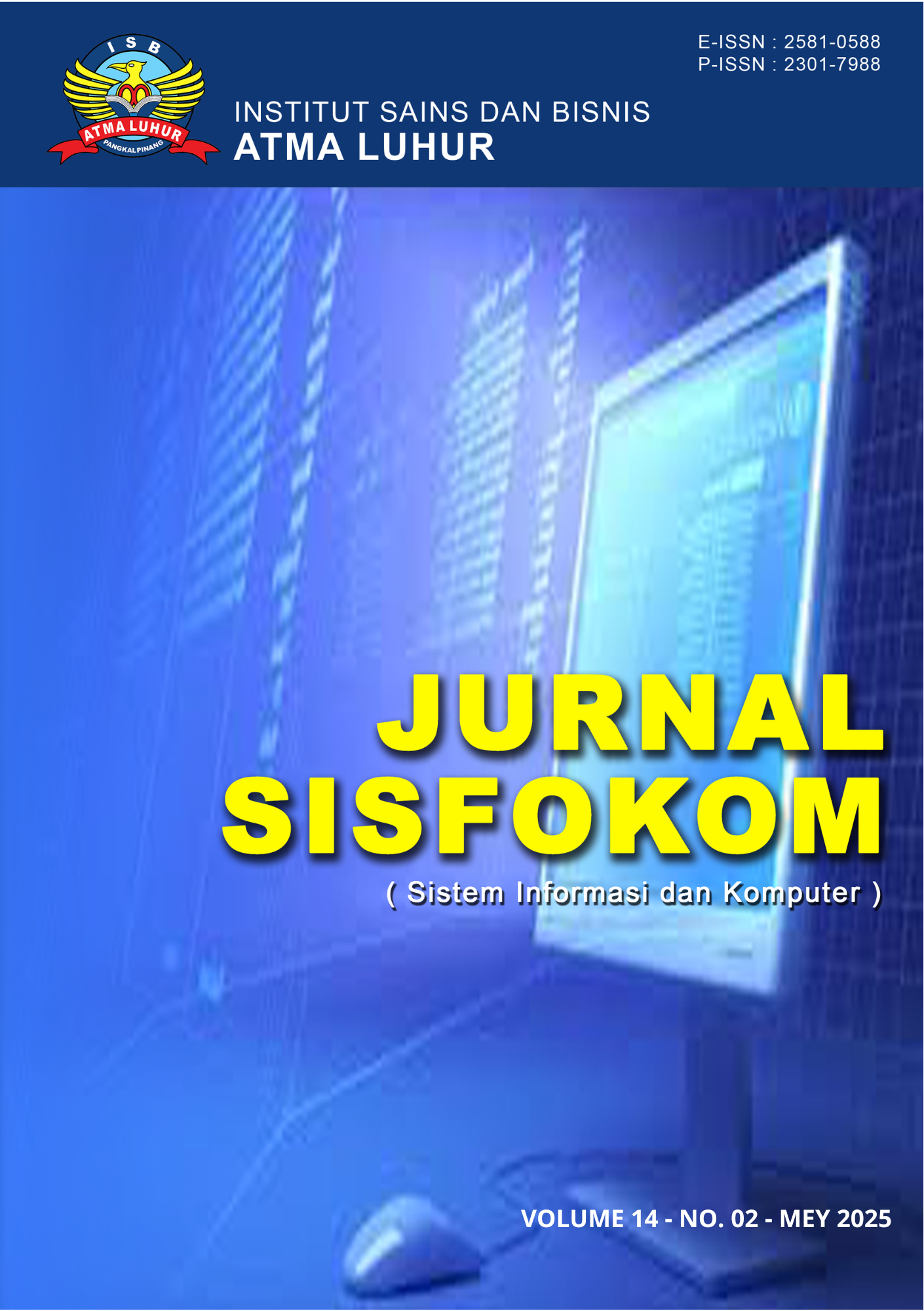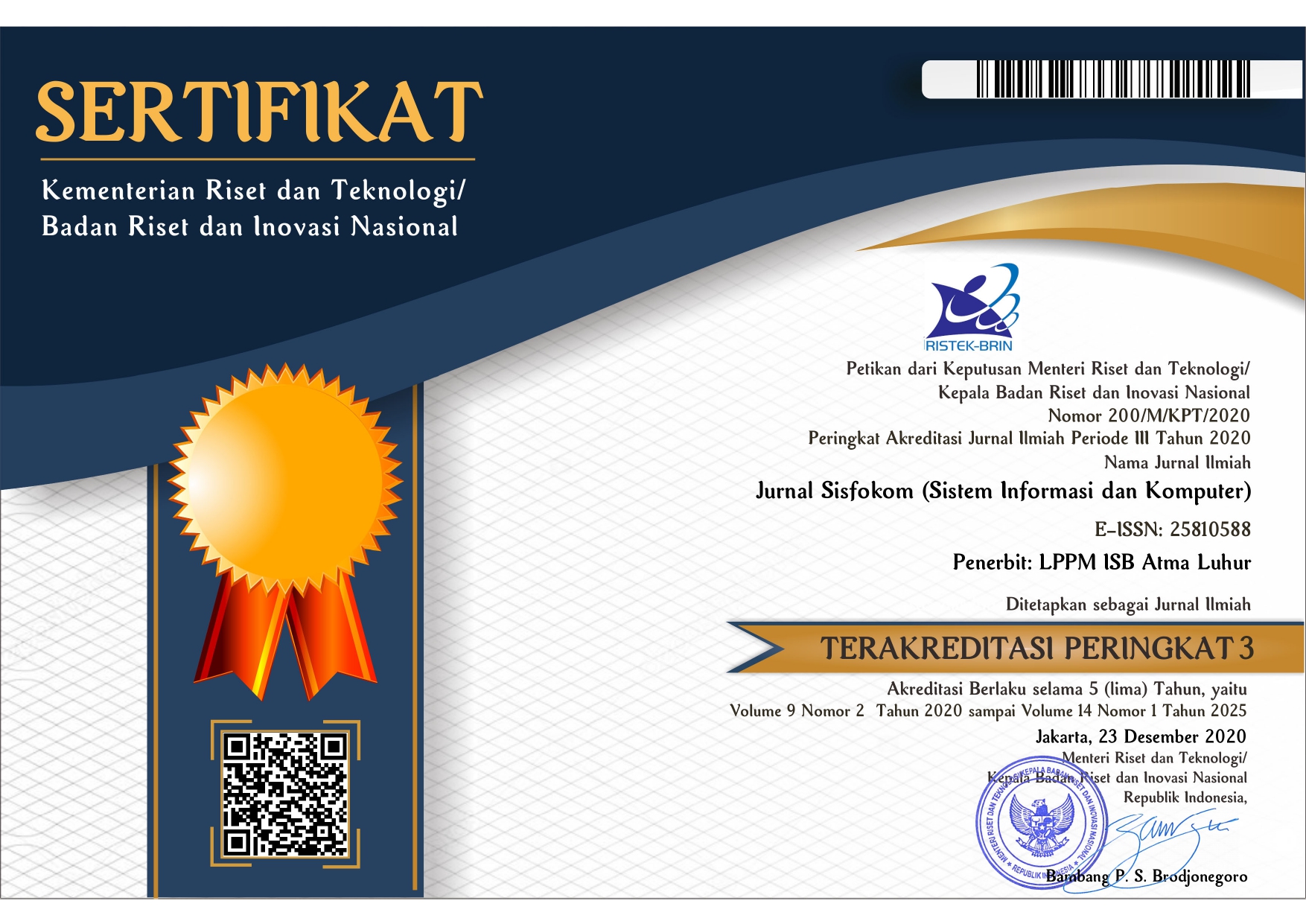Comparison of CNN Architectures for Pre-Cancerous Cervical Lesion Classification Based on Colposopy Images Using IARC and AnnoCerv Datasets
DOI:
https://doi.org/10.32736/sisfokom.v14i2.2361Keywords:
Cervical Cancer, Colposcopy Image Classification, CNN, CIN Classification, Machine LearningAbstract
Cervical cancer represents a significant public health issue affecting women worldwide, and identifying the severity of lesions early on is crucial to selecting the right treatment. This research investigates and compares the effectiveness of various Convolutional Neural Network (CNN) models in classifying colposcopic images according to the severity of cervical lesions. The dataset used was obtained from the International Agency for Research on Cancer (IARC) and AnnoCerv, consisting of 452 colposcopy images categorized into four classes: Normal, CIN 1, CIN 2, and CIN 3. Five CNN architectures were evaluated: MobileNetV2, InceptionV3, Xception, VGG16, and DenseNet121. Experiments were conducted using default hyperparameters: batch size of 32, learning rate of 0.001, and 100 epochs. The results showed that MobileNetV2 achieved the highest accuracy at 67%, followed by DenseNet121 (60%), Xception (60%), InceptionV3 (55%), and VGG16 (42%). Based on these findings, MobileNetV2 is the most optimal model for classifying colposcopy images in this study. However, the study is limited by class imbalance and dataset size, which may affect model generalizability. Future work may explore ensemble learning techniques and larger, more diverse datasets for improved accuracy.References
A. Chaddad, J. Peng, J. Xu, and A. Bouridane, “Survey of Explainable AI Techniques in Healthcare,” Jan. 01, 2023, MDPI. doi: 10.3390/s23020634.
N. A. Zebari et al., “A deep learning fusion model for accurate classification of brain tumours in Magnetic Resonance images,” CAAI Trans Intell Technol, vol. 9, no. 4, pp. 790–804, Aug. 2024, doi: 10.1049/cit2.12276.
E. O. Simonyan, Joke. A. Badejo, and J. S. Weijin, “Histopathological breast cancer classification using CNN,” Mater Today Proc, vol. 105, pp. 268–275, 2024, doi: https://doi.org/10.1016/j.matpr.2023.10.154.
A. Faghihi, M. Fathollahi, and R. Rajabi, “Diagnosis of skin cancer using VGG16 and VGG19 based transfer learning models,” Multimed Tools Appl, vol. 83, no. 19, pp. 57495–57510, 2024, doi: 10.1007/s11042-023-17735-2.
H. Sung et al., “Global Cancer Statistics 2020: GLOBOCAN Estimates of Incidence and Mortality Worldwide for 36 Cancers in 185 Countries,” CA Cancer J Clin, vol. 71, no. 3, pp. 209–249, May 2021, doi: https://doi.org/10.3322/caac.21660.
P. A. Cohen, A. Jhingran, A. Oaknin, and L. Denny, “Cervical Cancer,” The Lancet, vol. 393, no. 10167, pp. 169–182, Jan. 2019, doi: 10.1016/S0140-6736(18)32470-X.
J. M. M. Walboomers et al., “Human papillomavirus is a necessary cause of invasive cervical cancer worldwide,” J Pathol, vol. 189, no. 1, pp. 12–19, Sep. 1999, doi: https://doi.org/10.1002/(SICI)1096-9896(199909)189:1<12::AID-PATH431>3.0.CO;2-F.
J. Liu, L. Li, and L. Wang, “Acetowhite Region Segmentation in Uterine Cervix Images Using a Registered Ratio Image,” Comput Biol Med, vol. 93, pp. 47–55, 2018, doi: 10.1016/j.compbiomed.2017.12.009.
E. Hussain, L. B. Mahanta, K. A. Borbora, H. Borah, and S. S. Choudhury, “Exploring explainable artificial intelligence techniques for evaluating cervical intraepithelial neoplasia (CIN) diagnosis using colposcopy images,” Expert Syst Appl, vol. 249, p. 123579, 2024, doi: https://doi.org/10.1016/j.eswa.2024.123579.
N. A. Alias et al., “Pap Smear Images Classification Using Machine Learning: A Literature Matrix,” Dec. 01, 2022, Multidisciplinary Digital Publishing Institute (MDPI). doi: 10.3390/diagnostics12122900.
P. B. Shanthi, K. S. Hareesha, and R. Kudva, “Automated Detection and Classification of Cervical Cancer Using Pap Smear Microscopic Images: A Comprehensive Review and Future Perspectives,” 2022, Engineered Science Publisher. doi: 10.30919/es8d633.
O. Yaman and T. Tuncer, “Exemplar pyramid deep feature extraction based cervical cancer image classification model using pap-smear images,” Biomed Signal Process Control, vol. 73, p. 103428, 2022, doi: https://doi.org/10.1016/j.bspc.2021.103428.
B. J. Cho et al., “Classification of Cervical neoplasms on Colposcopic Photography using Deep Learning,” Sci Rep, vol. 10, no. 1, pp. 1–10, Aug. 2020, doi: 10.1038/s41598-020-70490-4.
V. Chandran et al., “Diagnosis of Cervical Cancer based on Ensemble Deep Learning Network using Colposcopy Images,” Biomed Res Int, vol. 2021, no. 1, May 2021, doi: 10.1155/2021/5584004.
S. Saini, K. Ahuja, S. Chennareddy, and K. Boddupalli, “Deep Learning Descriptor Hybridization with Feature Reduction for Accurate Cervical Cancer Colposcopy Image Classification,” Pattern Recognit Lett, May 2024, doi: 10.48550/arXiv.2405.01600.
M. Sandler, A. Howard, M. Zhu, A. Zhmoginov, and L.-C. Chen, “MobileNetV2: Inverted Residuals and Linear Bottlenecks,” in 2018 IEEE/CVF Conference on Computer Vision and Pattern Recognition, 2018, pp. 4510–4520. doi: 10.1109/CVPR.2018.00474.
C. Szegedy, V. Vanhoucke, S. Ioffe, J. Shlens, and Z. Wojna, “Rethinking the Inception Architecture for Computer Vision,” in 2016 IEEE Conference on Computer Vision and Pattern Recognition (CVPR), 2016, pp. 2818–2826. doi: 10.1109/CVPR.2016.308.
F. Chollet, “Xception: Deep Learning with Depthwise Separable Convolutions.”
K. Simonyan and A. Zisserman, “Very Deep Convolutional Networks for Large-Scale Image Recognition,” ICLR, Apr. 2015, [Online]. Available: http://arxiv.org/abs/1409.1556
G. Huang, Z. Liu, L. Van Der Maaten, and K. Q. Weinberger, “Densely Connected Convolutional Networks,” in 2017 IEEE Conference on Computer Vision and Pattern Recognition (CVPR), 2017, pp. 2261–2269. doi: 10.1109/CVPR.2017.243.
D. A. Minciună et al., “AnnoCerv: A new dataset for feature-driven and image-based automated colposcopy analysis,” Acta Universitatis Sapientiae, Informatica, vol. 15, no. 2, pp. 306–329, Dec. 2023, doi: 10.2478/ausi-2023-0019.
Downloads
Published
Issue
Section
License

This work is licensed under a Creative Commons Attribution 4.0 International License.
The copyright of the article that accepted for publication shall be assigned to Jurnal Sisfokom (Sistem Informasi dan Komputer) and LPPM ISB Atma Luhur as the publisher of the journal. Copyright includes the right to reproduce and deliver the article in all form and media, including reprints, photographs, microfilms, and any other similar reproductions, as well as translations.
Jurnal Sisfokom (Sistem Informasi dan Komputer), LPPM ISB Atma Luhur, and the Editors make every effort to ensure that no wrong or misleading data, opinions or statements be published in the journal. In any way, the contents of the articles and advertisements published in Jurnal Sisfokom (Sistem Informasi dan Komputer) are the sole and exclusive responsibility of their respective authors.
Jurnal Sisfokom (Sistem Informasi dan Komputer) has full publishing rights to the published articles. Authors are allowed to distribute articles that have been published by sharing the link or DOI of the article. Authors are allowed to use their articles for legal purposes deemed necessary without the written permission of the journal with the initial publication notification from the Jurnal Sisfokom (Sistem Informasi dan Komputer).
The Copyright Transfer Form can be downloaded [Copyright Transfer Form Jurnal Sisfokom (Sistem Informasi dan Komputer).
This agreement is to be signed by at least one of the authors who have obtained the assent of the co-author(s). After submission of this agreement signed by the corresponding author, changes of authorship or in the order of the authors listed will not be accepted. The copyright form should be signed originally, and send it to the Editorial in the form of scanned document to sisfokom@atmaluhur.ac.id.









